IMEHA (International Model Equine Hobbyists Association) was an online photo showing site that existing until 2018. Included on the site were these guidebooks for judging and showing model horses in Performance classes. MEPSA has obtained permission to share the info contained in the guides.
Scoring :: Point Deducts :: Tack :: Set-Up Options :: Photo Examples
This class is seen in the non rider shows and is judged on manners and performance of the horse. The Western bareback pleasure horse regardless of breed performs with a lower head than a natural one, relaxed gaits, slow jog, slow lope and smooth loose or light rein. The head and neck should be carried appropriately for a relaxed performance in accordance to the horse’s breed type and conformation. A National Show Horse for example would carry it’s muzzle above the point of it’s shoulder, while a Morgan will be lower and an Arabian lower still but with it’s poll well above the withers. Stock breeds carry a flat or level neck and in all cases the horse’s face is vertical or near vertical. Over bridling and over extension of any horse (nose before the vertical) is undesirable. Non stock horses will tend to demonstrate greater contact on the bit, in keeping with a more elevated head set. Morgans are ridden western in a “California” style, which better suits an up headed horse. The California style horse is more on the bit and on a fairly loose rein but not the slack rein seen in the stock breeds. Gaits are a true four beat walk, straight and relaxed; a slow easy jog, and a relaxed easy lope. Some divisions call for a hand gallop. Gaited horses such as Tennessee Walkers, Missouri Fox Trotters, Rocky Mountain Horses, etc. perform their gait instead of the jog. The degree of action in either the trot or whatever pacing gait of the breed, should be consistent with a relaxed performance and the horse’s individual conformation.
The correct fit of the headstall, bit and reins also play a large part of the judging of this class. Please read the Western Pleasure Arena Section for more information.
Sticky wax also plays and important part to showing in this class. Be sure to set your reins correctly using it and do not just lay the reins across or on the horse’s back. Reins should give the appearance that they are being held in a rider’s hand if that rider were present in the photo. See reference photo’s below.
For additional helpful hints for a correct fit of the Western Bridle please check out Susan Hargrove’s site at: Oh Joy Farms – Western Bridle Basics 101.
You Score Western Pleasure Gaits on the following:
The Walk:
(1) Poor walk – uneven pace and no cadence. Has no flow and may appear intimidated or appear to march.
(2) Average walk – has a four-beat gait, level top-line and is relaxed.
(3) Good walk – has a flowing four-beat gait, level topline, relaxed and is bright and attentive
The Jog:
(1) Extremely poor jog – cannot perform a two-beat gait and has no flow or balance in the motion.
(2) Very poor jog – hesitates in the motion. Does not keep an even and balanced motion or a level top-line. May appear to shuffle.
(3) Poor jog – average motion but has negative characteristics such as; walking with the hind legs, dragging the rear toes or taking an uneven length of stride with the front and rear legs.
(4) Correct or average jog – has a two-beat gait, a level top-line and a relaxed appearance.
(5) Good jog – has an average motion with positive characteristics such as balance and self-carriage while taking the same length of stride with the front and rear legs.
(6) Very good jog – is comfortable to ride while having a consistent two-beat gait. The horse guides well, appears relaxed and has a level top-line.
(7) Excellent jog – effortless and very efficient motion. Swings the legs yet touches the ground softly. Confident, yet soft with its motion while being balanced and under control. Moves flat with the knee and hock and has some cushion in the pastern. Has a bright and alert expression and exhibits more lift and self-carriage than the “very good jog”.
Moderate Extended Jog:
(1) Poor extended jog – never lengthens the stride and may appear rough to ride.
(2) Average extended jog – moves up in its pace and appears smooth to ride.
(3) Good extended jog – has an obvious lengthening of stride with a slight increase in pace while exerting less effort and appears smooth to ride.
The Lope
(1) Extremely poor lope – does not have a three-beat gait. Has no flow, rhythm or balance. Uncomfortable to ride.
(2) Very poor lope – appears to have a three-beat lope but has no lift or self-carriage. The horse shuffles, has no flow and bobs his head, giving the appearance of exerting a great deal of effort to perform the gait. Also may appear uncomfortable to ride.
(3) Poor lope – has an average motion but exhibits negative characteristics like head bobbing, not completing the stride with the front leg and leaving the outside hock well behind the horse’s buttocks.
(4) Average lope – has a true three-beat gait with a level top-line and very little head and neck motion. He is relatively straight (not over-canted), guides well and has a relaxed appearance.
(5) Good lope – has an average motion but exhibits positive characteristics in his performance like self-carriage, a steady topline, relaxed appearance and is responsive to the rider’s aids.
(6) Very good lope – has more lift and flow than the average horse. He has a strong but smooth drive from behind. He may bend his knee slightly yet still has a level top-line while exhibiting self-carriage with a relaxed appearance. Appears comfortable to ride.
(7) Excellent lope – has a round back with an effortless strong, deep stride with the rear legs and a flat swing with the front legs. He keeps a level top-line, a relaxed yet alert and confident appearance and is correct but soft. A special horse with a great degree of lift and self-carriage.
The Back-Up:
(1) Poor back-up – is resistant and heavy in front. May gap the mouth and throw his head or back crooked.
(2) Average back-up – backs straight and quietly with light contact and without hesitation.
(3) Good back-up – displays balanced and smooth flowing movements. Backs straight with self-carriage without gapping the mouth with light contact and without hesitation.
Extra Credit Should Be Given If:
(1) split reins are used, the rein should fall on the same side as the rein hand.
(2) a romal rein is used; romal should fall on the opposite side from the rein hand (romal is usually held in the rider’s other hand).
(3) an Entry Number is shown on saddle blanket or on rider’s back.
Points Should Be Deducted If:
(1) Model exhibits excessive speed for gait assigned.
(2) Model is on the wrong lead.
(3) Model appears to display a slowness in any gait or loss of forward momentum resulting in an animated and/or artificial gait at the lope.
(4) Model’s head is carried too high.
(5) Model’s head carried too low; tip of ear below the withers.
(6) Model is over flexed or has a strained neck in head carriage, so the nose is carried behind the vertical.
(7) Model displays excessive nosing out.
(8) Model displays an open mouth excessively.
(9) Rider uses spurs forward of the heartgirth.
(10) Model appears sullen, dull, lethargic, emaciated, drawn or overly tired.
(11) Model appears agitated; has ears back, tail twirled, etc.
(12) Model displays quick, choppy or pony strides.
(13) Reins are draped to the point that light contact is not maintained.
(14) Model is overly canted at the lope. *When the outside hind foot is further to the inside of the arena than the inside front foot.
Required Tack:
Silver should not be counted over a good working bridle and reins. A western style bridle (browband, one ear, two ear, with or without throatlatch) with a curb bit including a curb strap or curb chain. Standard snaffle bit and bosal hackamores are permitted on horses 4 and under (5 and under for Arabians and Appaloosas). Romal reins and split reins are both legal; Romal reins are usually seen on Arabians, Morgans, and NSH. Missouri Fox Trotters usually wear a noseband.
Prohibited Tack:
A western saddle. Nosebands or cavessons (except: Missouri Fox Trotter and National Spotted Saddlebred/Walking Horse). Any type of martingale or tiedown, tapaderos, roping reins, any kind of boots or bandages, crops or whips, mechanical hackamores are also prohibited. Split reins may not be knotted or attached to each other (stick wax is of course permitted in model horses) Rider may not have more than one finger between split reins or any fingers between the reins of a rein and romal.
Set-Up Options:
Arena Fencing Required (Indoor or Outdoor Arena)
Types of Fencing Allowed:
- Painted or Natural
- Post and Rail
- Post and Plank
- Chain Link
- Solid Plyboard
- Plyboard with Top Rail
- Post with Drape Rope
- Stock Tube Pipe Rail
- Interior Arena Wall
Footing Required:
- Dirt
- Sand
- No grass base
- No rock base
Backboard or Natural Setting (Indoor or Outdoor)
Examples of the Four Breed Divisions:
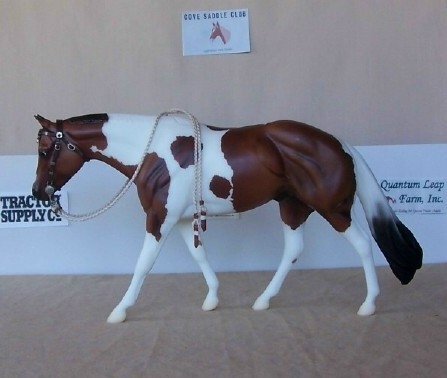
Western Pleasure Arena
Stock Breed Entry
Painted Dreamz, Bay Tobiano Paint Stallion, Mold: Breyer Zippo Pine Bar SR owned and shown by Kathy Scheuers.

Western Pleasure Arena
Arabian Breed Entry
BRs Esquire, shown as a Bay Arabian Stallion, Mold: Vintage OF Breyer Khemosabi Using a Comment Line of: Western Bareback: Esquire at a quiet walk before moving into a jog at the judges request. Owned and shown by Rebecca Eggers.
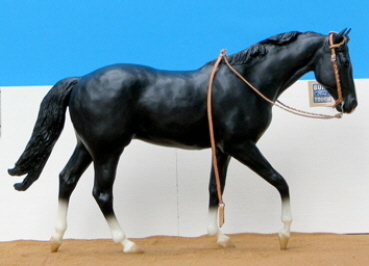
Western Pleasure Arena
TB/WB or Sporthorse Breed Entry
CH Sailor, shown as a Black TB Gelding, Mold: OF Breyer #836. Owned and shown by Randa Garrett.
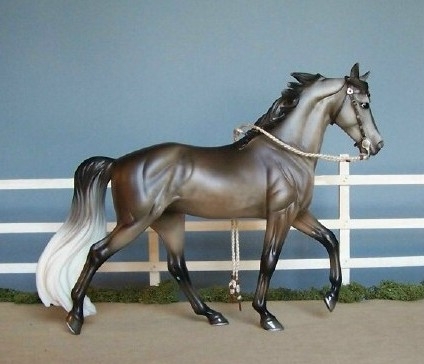
Western Pleasure Arena
Other Breed Entry
Steel Magnolias, Dapple Grey McCurdy Plantation Horse Mare, Mold: Breyer Bluegrass Bandit. Owned and shown by Kathy Scheuers.
Hold the Reins Correctly:
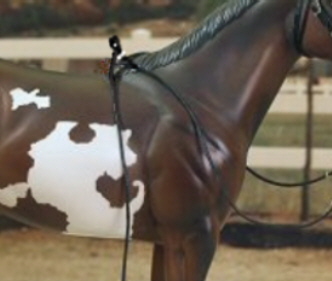
Romal Reins
With no rider the romal reins should stand up as though the romal reins have entered an imaginary hand from underneath it and exited that same imaginary hand on top over the thumb. The knot would be at the top of the “stand” forming an imaginary junction of the reins and the romal whip. This effect can be achieved by using sticky wax. It is suggested that if you are depicting romal reins in your bareback photo that you hang the romal whip on the same side as the camera lens so judge’s can easily tell that it is romal reins and not split reins.

Split Reins by Kathy Scheuers
With no rider the split reins can be held in the right or left hand. The excess rein hang over untouched on the same side of the horse. So if right hand hold the rein then the excess rein lies on the right side of the horse. If left hand holds the rein then the excess rein lies on the left side of the horse. It is suggested that if you are depicting split reins in your bareback photo that you hang the ends on the same side as the camera lens so judge’s can easily tell that it is split reins. The reins should rise up like they were going into the rider’s hands. This effect can be achieved by using sticky wax.

Snaffle Reins by Kathy Scheuers
The snaffle rein crosses over the horse’s neck with the bight extending down ward on the opposite side of the horse’s neck. Both hands are used on the reins by picking the rein and the bight up with the palms of the hands facing down. The reins should rise up like they were being held by both hands. This effect can be achieved by using sticky wax.
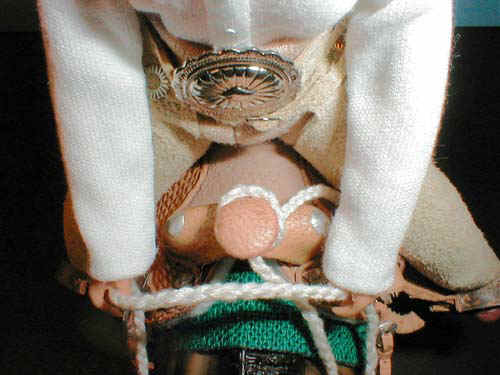
Hackamore Mecate Reins by Susan Hargrove
The hackamore mecate rein is a solid single loop rein with the bight tied from the bosal to either the saddle horn or coiled and tied to the front piggin string (or swell string) of the saddle. Both hands are used on the rein by picking the rein with the palms of the hands facing down.
